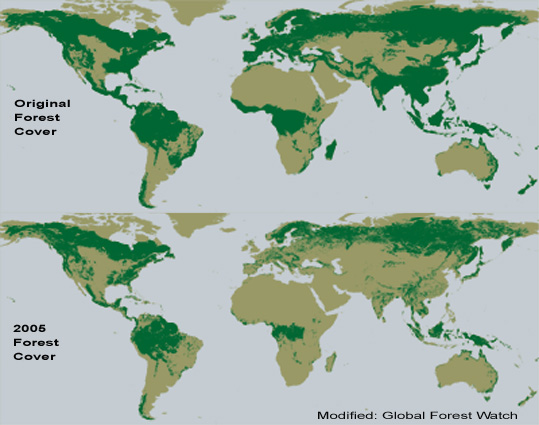The Double Whammy of Deforestation
Deforestation by burning, a widespread practice in the world’s tropical rain forests, adversely impacts the trace-gas composition of the atmosphere in two different ways. First, the burning of the tropical forests produces large amounts of carbon dioxide, carbon monoxide, methane, and other trace gases that are products when biomass burns. Second, the tropical forest is an important sink, or repository, for carbon dioxide. Atmospheric carbon dioxide is incorporated into the living biomass via the process of photosynthesis, which in turn produces the oxygen we breathe.
The Past
Much of the Earth was once covered by trees, but the majority of these were cleared long ago to make way for an ever expanding human population. This is particularly true in regions with a temperate climate such as Britain and other parts of Europe where agriculture took an early hold of the landscape. Interestingly, the World Wide Forest Report found that when the Roman Empire was in control of Europe 90% of the continent was forested, and sadly Western Europe has now lost over 99% of its primary forest. It is only in relatively recent times that the tropical forests have come under severe attack. On a global scale there was twice as much tropical forest at the turn of the 20th century as there is today, and only around 700 million of the original 1.5 billion hectares remain.

Causes
Commercial logging, clearance for agriculture, roads and railways, forest fires, mining and drilling, fuel wood collection and clearance for living space are all intimately connected with deforestation, but it is far from obvious as to which is the worst culprit.
People have been living in and around tropical rain forests for tens of thousands of years, taking what they needed from the wealth of natural resources available without compromising their environment. However, in the last two centuries populations have expanded, requiring more and more space for housing and agriculture. Coupled with the extremely lucrative international timber trade in recent years, this has brought about an unparalleled degradation of the rain forests.
The Rate of Deforestation
The Food and Agriculture Organization (FAO) estimates that 53,000 square miles of tropical forests (rain forest and other) were destroyed each year during the 1980s. Of this, they estimate that 21,000 square miles were deforested annually in South America, most of this in the Amazon Basin. Based on these estimates, an area of tropical forest large enough to cover North Carolina is deforested each year!
Consequences
Forests absorb a lot of sunlight for photosynthesis, and only about 12 to 15% is reflected. The large amounts of energy absorbed by forests acts to stimulate convection currents in air which enhance the production of rainfall. Tropical rainforests in particular are very wet and humid places. Deforested areas, by contrast, reflect about 20% of incoming sunlight. Deforested areas consequently, can become drier as a result of the loss of vegetation, increasing the risk of desertification. As the area of deforestation increases, so the impact on climate grows.
Trees also absorb carbon dioxide from the atmosphere for photosynthesis, and therefore help to regulate the natural greenhouse effect. Deforestation takes away a potential sink for the carbon dioxide we are pumping into the atmosphere. In addition, if forests are removed by burning, a lot of extra carbon dioxide locked up in tree wood is returned to the atmosphere. Carbon stored in forest biomass, deadwood, litter and soil together is roughly 50 percent more than the amount of total carbon in the atmosphere.
The Future
No plan to save the rainforests will succeed unless it takes into account the people in the rainforest countries and how they will achieve their livelihood. Third World nations, deep in financial crisis, have little interest in saving the rainforest unless they can be shown that it also makes economic sense.
Simply banning the timber trade or establishing reserves will not be enough to salvage the world’s remaining tropical rainforests. In order for the forest to be preserved, the underlying social, economic, and political reasons for deforestation must be recognized and addressed. Once the issues are brought into the light, the decision can be made about what should be done.
If it is decided that rainforests must be saved, then the creation of multi-use reserves that promote sustainable development and education of local people would be a good place to start. Currently about 6 percent of the world’s remaining forests are protected, meaning that over 90 percent are still open for the taking. However, even this 6 percent is not safe if the proper steps towards sustainable development are not taken. If possible, reforestation and restoration projects should be encouraged if we hope to come out of this situation without serious, long-term consequences.
Why not volunteer with tree planting groups and get involved for a few hours each year to reinvigorate yourself and our Earth? If you are unable to get out and plant, or spare the time, then purchase trees to be planted on your behalf.
